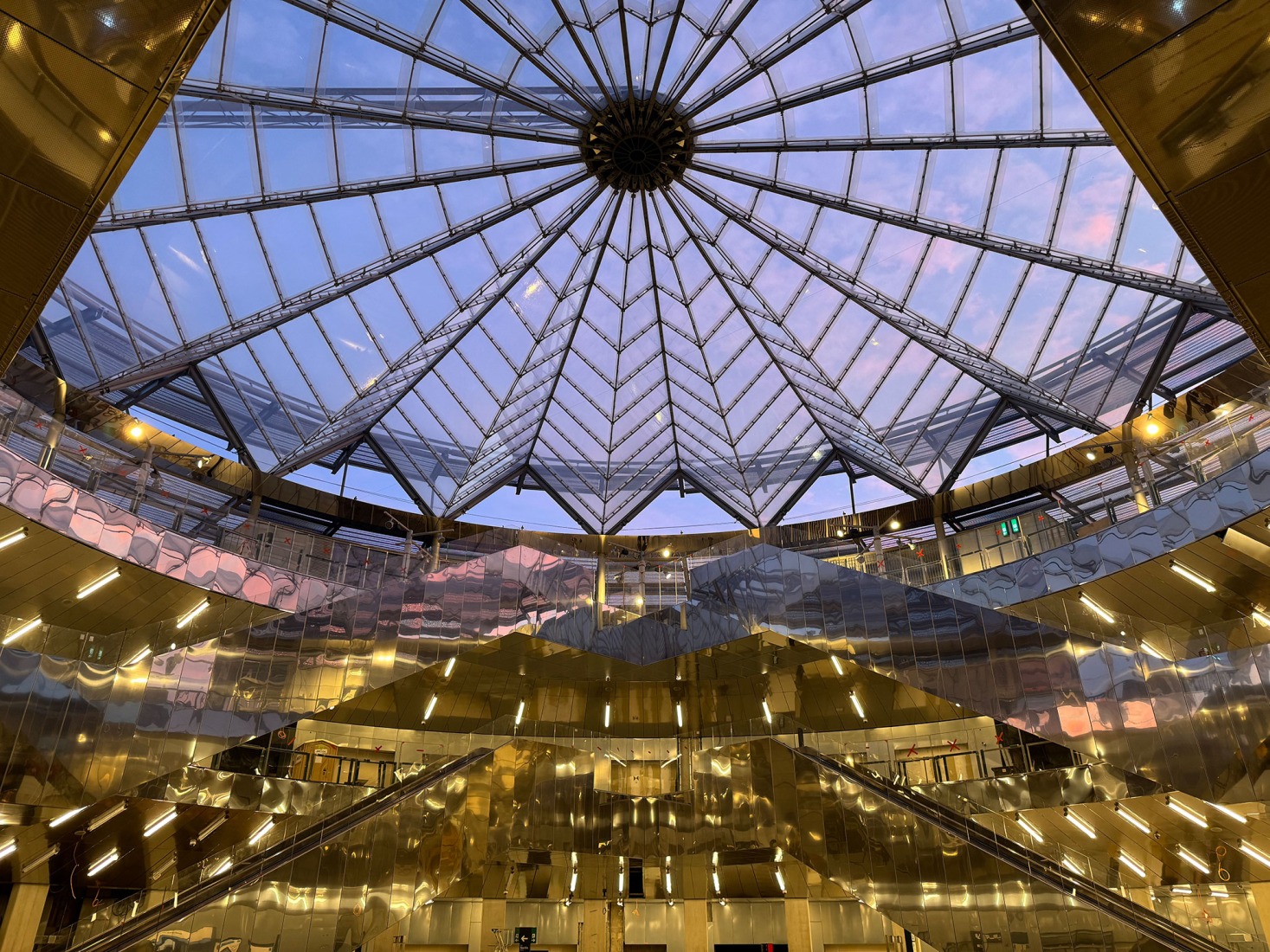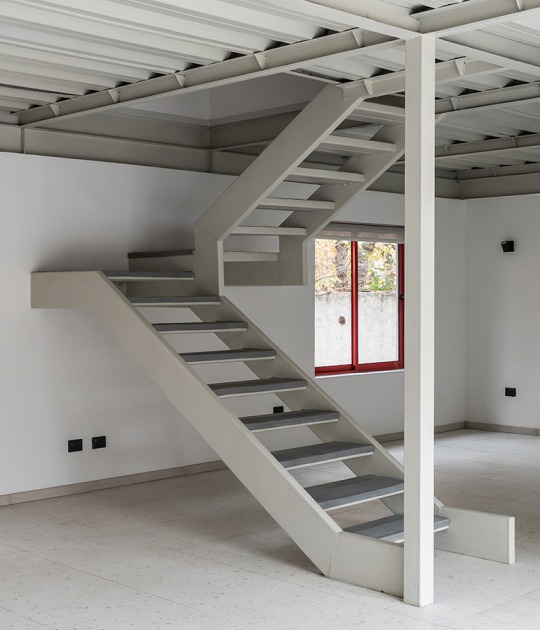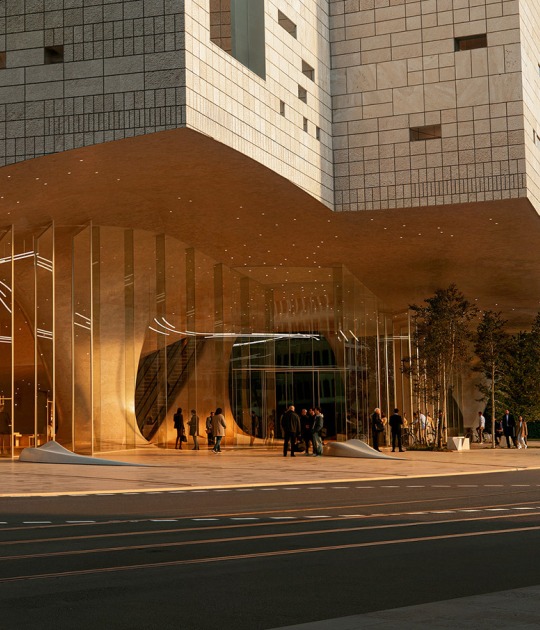
"The Villejuif-Gustave Roussy Station (by Dominique Perrault) aims to erase the threshold between the open public space and the closed space of the station by blurring the limits of the city. Its helicoidal architecture on the surface exerts a centripetal force on the urban fabric which draws it towards the space that has been completed underground. The large concrete cylinder with its moulded wall, flooded with light, is traversed, and enlivened by footbridges and escalators. Here, the sky of this inverted skyscraper is simply the ground level of the city. Natural light pours all the way down to the platforms located some fifty meters below. The sky is above the railways.
This exposed infrastructure is given maximum visibility and incorporates the logic of construction. The architectural layout is part of the urban cityscape. By erasing in the ground and prolonging uses and views between the surface and the subterranean domain, it unifies the vertical dynamics of access to the transport network. The architectural treatment transfigures this infrastructure now become architecture.
Without walls of façade, the architecture of this station sunken into the ground is not in opposition to the city or anything else. It frees the horizon and disappears from the urban silhouette, swallowing up with it then bit of sky."
Dominique Perrault.

Gustave Roussy Station by Dominique Perrault Architect. Photograph by Michel Denancé.
Project description by Dominique Perrault Architecture
The Groundscape and the territory
Today, the Grand Paris Express is the largest project of civil engineering in Europe including over 200 km of automated lines and 68 new stations. It involves first and foremost a territorial project and the making of a new city in sync with the collective aspirations for a new urban experience. The Grand Paris Express is a major piece of this major bet of the metropolis.
A new territory is taking shape before our eyes, made available to the greatest number. The objective is not merely to ensure access to the capital to all inhabitants of the region but also to develop new zones of live and activity across the entire metropolitan region. The development of the districts surrounding the new stations of the Grand Paris Express is, in that sense, a challenge of urbanity inherent to the territory’s programme of metropolization. Their perimeters, defined as a circle of 800m of circumference, will represent nothing less than one and a half times the size of Paris proper and more than twenty percent of the population of the new metropolis.
What are the challenges facing Grand Paris? Increasing the hospitality of cities, exurban and rural zones, rectifying spatial segregation and relegation of every type, encouraging social diversity without further weakening the most disadvantaged citizens, promote housing and new modes of habitat, optimise mobility, intensify the connexions between urban centres, contribute to the boosting labour markets, and, finally, to the emergence of the sustainable metropolis facing the challenge of climate change.

A metropolitan station
Located on the highest point of the Longboyau Plateau, in the departmental park of the Hautes Bruyères, the Villejuif-Gustave Roussy Station, with a depth of some 50 metres separating the street level from the one of the platforms, will be one of the deepest transport infrastructures in France. Located on the line 15 South, which links Pont de Sèvres with Noisy- Champs, the future Villejuif Institut Gustave-Roussy will create the interconnexion with the extended line 14 and will welcome some 100,000 passengers every day from January 2025. It will serve the ZAC Campus Grand Parc and the Institut Gustave-Roussy, the leading cancer treatment centre in Europe. An emblematic station of the Réseau du Grand Paris Express, owing as much to the role of infrastructure in developing the territory, as to the interconnexion it will ensure between two metro lines, the architecture for the future station expresses the determination of the project to place in dialogue, unite, and federate these spaces.
Extending the city underground
There is no formal demonstrativeness or eccentricity from the design point of view. Essentially developed below ground, on the surface takes the appearance of a pavilion, and blends the outside with the inside, the infrastructural and the urban. It structures the emergence of new territory of the Grand Paris, andcontributes to the transformation of the city into a metropolis, and the suburbs into a city. It involves placing the hospital centre in a network and transforming its surrounding district onto a campus.

The station as an element of this system, is a “place of exchange”, a central element of the interconnexions between the major hospital, future office and housing buildings and the large park. It will also create a link between the urban and landscape places, by extending the uses and the views between above and below. A generous space, the station stretches, loosens, and infiltrates the underground, like an extension of the city below ground.
Its architecture is designed in the continuity of the surrounding public space. It does not oppose the city, stand against it, raise up anu sort of façade, no wall. This station must be grasped as a connector of the world below with the world above, and vice versa. It is a great cylinder, open, empty, with a diameter of 70 metres. An emptied 30 metres inside the cylinder, surrounded by galleries and balconies, welcomes the great escalators. The engineering studies were developed in a way that design of the infrastructure corresponds to the design of the station: light and readable architecture that accompanies flows as naturally as possible.

Connecting the Gustave Roussy Hospital with the larger network
On the level of the square, the forecourt leads naturally towards the first balcony overlooking the central void. Little kiosks house a range of services and punctuate the periphery of the station. Walls draped with metal mesh enable the closure of the station. These elements are a light form of limit offing view onto the city and the park. Open access (i.e., without a ticket) is possible down to level -2. The first two levels of balcony galleries house shops and services, accentuating the continuity of the station with the public space above.
The project facilitates easy comprehension of the space and the circulations. When leaving the platforms, directly linked to the vast central void, users easily find their bearings and directions. From the two levels of platforms – the two metro lines being located in two perpendicularly superimposed tunnels - monumental escalators lead to the surface, guided by natural light.

An open-air station
The station benefits from natural light and ventilation. In direct contact with the platforms, the vast central void and the various balcony circulations are bathed in natural light and open air. This principle is what makes one of the forms of prowess of this infrastructure possible, i.e., the one of eliminating the need for smoke extractors in its central part (the well). Travellers will also be in contact with the ambient temperature, which is more temperate at this depth than on the surface, without reliance on additional heating.
The roof over the station is composed of three layers. A centrale transparent circular one protects from rain while allowing outside air to circulate laterally. This roof consists of a one peripheral beam on which all the tie rods and cables are linked with the central hub, the “eye” of the station. Stretched over the cables are elements made of ETFE (ethylene tetrafluoroethylene), the material chosen for its high quality of transparency, lightness, resistance, and its great fineness. Two other roofs, non -concentric disks placed at two different heights, cover the station. Like two great marquees, they radiate over the forecourt and signal the presence of the station whilst also ensuring user protection from the sun, like sunshades over the public space. They are composed of strips of stainless-steel spiralled metal mesh, stretched between the radial rafters.

Resilience
Resilience is a word of our times. A programming word, capable of creating a system given that it predicts the future of human societies facing planet-wide climatic shock, along with these watch words: assimilate, endure, react, subsist.
By resilience, one designates the ability of materials to resist forces of rupture and weather. By choosing concrete for the structure and glass and stainless steel for cladding, the station is anchored in the determination of solidity and durability. The overall composition is minimal and all the elements have a function, whether structural or technical. By employing natural resources available underground, the station is as delicately integrated as possible in its environment, which enables, among other advantages, to insulate the interior from the exterior earth and to maintain a constant temperature by using the surrounding earth, thereby eliminating the need for additional heating, air-conditioning, or smoke extraction. This ensures important cost savings, sustainability, and comfort of users.
The “sous-terrestre”
The world underground is often synonymous with discomfort, cold, mystery, and obscurity. The station being anchored in the deep whilst allowing light and air to pour in, it offers users the opposite experience. As users penetrate this space, they understand that the ground is no longer anxiety-provoking, closed, and damp, but rather that it offers comfort and an experience engaging all the senses. The central well makes it possible to gather in the heart of this innovative facility all travellers who, though in transit, are in contact with what is happening inside. By confusing the public space and the station, the project transgresses the traditional terminology of buried works to become a fully public facility. It is in this sense that the station is the extension of the city in that we encounter the same ambiance whether we are above or below.

The station is no longer merely a work of transport infrastructure, and a place of circulation, but now it has become a lively place of exchange offering users, beyond simply a concentration of services, new forms of urban living, between individual pathways and the public space. Places in the fullest sense of the term, endowed with qualities, able to host uses that exceed transport.
Materiality, light, acoustics
Gaëlle Lauriot-Prévost, an associate of the Dominique Perrault Architecture firm, designed the interior layouts, lighting and acoustics. The materiality of the project makes use of stainless steel in a range of textures: smooth, mesh, perforated, mirror polish, and satiny. These finishings create different ambiances, whilst also favouring the propagation of light, through the play of reflections, brilliances, and filters.
Des disks with a surface area of 3,273 m², composed of swaths of spiralled stainless-steel mesh, stretched between radial beams, structure the exterior roof. Inside, 1,808 m² of silvery aluminium wire clad the great well, thus electrifying the heart of the station. Originally an industrial product, previously considered as cold and rigid, metal mesh is assigned a new function: neither wall nor structure, it is used to rethink the notion of protection, and acoustics, dematerialize volumes, introduce the play with lighting and reflection, and to clad here and there the station and its facilities.
On the ceiling, light fixtures and acoustic baffles alternate, giving the station a regular rhythm. Light from the industrial light fixtures blends with daylight and is reflected by the meatal surfaces, immersing travellers in a genuine light show.



























































